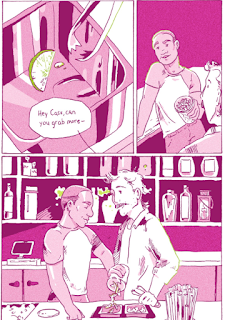Clover Ajamie is a CCS student whose comedian Bar Abet is a beautiful small cut-of-life romance that includes unfamiliar characters. That is now now not so much a myth as it’s a mercurial character impression. It follows Cass, a trans man and bartender who’s about to hasten on their shift. Some romantic possibilities are right now implied, as Cass’s associate Andie asks if an attractive bartender named Ryan shall be there. That is a huge example of a comedian guide that uses coloration to advance the emotional anecdote of a myth. The injurious coloration wash is a coral-crimson, and the accents are a lime-green. That is a spell binding choice as an accent, because that particular particular person hue tends to be related to sickly photography. Ajamie reimagines it as a form of free neon vitality (the bar’s signal is in this coloration) that presents emphasis to the romance later in the comedian between Ryan and Cass. There’s no trusty tension or myth in this guide rather than romantic tension; nothing harmful happens, nor fabricate we be taught much about these characters. That is now now not the level of the parable, however; or now now not it’s a moment in time, the variety of splendid moment that embeds itself in our consciousness, and Ajamie’s exhaust of coloration emphasizes this.
Ajamie’s Fairies, self-described as a piece in development, builds on the romance facets of Bar Abet in the context of a village of fairies that specializes in the kids. The dusky and white pencils are tranquil and nearly fragile, using a skinny line designed to play up the fabulist qualities of the woodland. Ajamie goes support and forth in time, lowering between moderately just a few characters and winding moderately just a few tales into one one more. It rings a bell in my memory barely of Robert Altman-kind scene flipping, as Ajamie builds character anecdote into the area-building facets of the parable. Each and each detail we be taught about the fairies is segment of studying something else about one in all the characters. To illustrate, we see one fairy grow mad at her buddy for making fun of her grandfather, who builds a instrument to reduction him grasp a shower. The effect of living level of interest of this segment of the parable, a dance for young fairies, is integrated with the embarrassing (to a teen) overattention from a mother, the boasts of fairies as to their beauty, and nerves about dancing. Ajamie succeeds by turning the unparalleled into the mundane, as the fantasy trappings fade into checking out what makes each and each character tick.
Ellie Liota’s Lamb To Slaughter is the roughly awe comedian that at its coronary heart is constant with a extraordinarily tainted gag. The kind and boldness of its gore remembers Emily Carroll, however Liota’s swear and kind are uniquely hers. A massive segment of that distinction is Liota’s right now setting up this as a myth about class as much as it’s miles the relaxation, and he or she uses the anthropomorphic animal characters for each and each literal and metaphorical purposes. It be fiendishly vivid, as the parable’s final, fine swerve is entirely earned, with any choice of clues setting up it along the manner. In this myth, we see a wolf coming support to her noble family’s account for and big manor residence. She’s greeted by a rabbit servant and then her mother, who is upset by bringing support real two sheep. The reader is then launched to accommodate intrigue, as the rabbit is the wolf daughter’s lover, and they’re planning to bustle away collectively. Nonetheless, something is off about the total ingredient, whilst the wolf mother kills the rabbit after overhearing the conspiracy. That leads the wolf daughter to almost peel off in bother, unless she sees the bust of a ram above the door; with renewed goal, she trudges support to space up the amazingly vivid climax that right now unearths the title has a double that manner. Liota’s cartooning is appropriately visceral, with the gentle coloration tones giving manner to the deep red of blood. It be rare that a cartoonist can successfully preserve a protagonist’s motive hidden for the massive majority of the parable, however Liota pulls it off by transferring the anecdote sand with this kind of gorgeous level of detail that the reader by no manner is conscious of what hits them.



